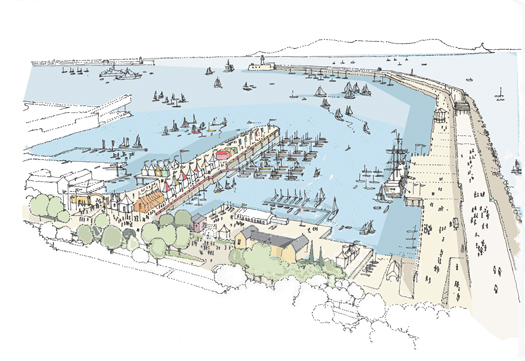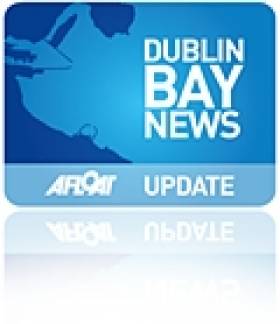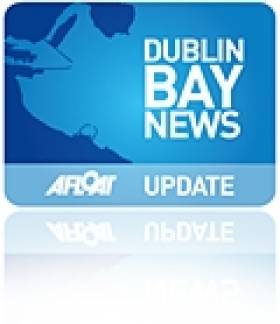Displaying items by tag: Dun Laoghaire Harbour Company
Dublin Bay it set to burst alive with 'joie de vivre' during the only foreign stopover in the world-famous Solitaire du Figaro yacht race.
Dun Laoghaire will be the only international stop in the race, considered the unofficial world offshore solo championship, between 11 and 14 August.
To celebrate the visit of the iconic 3,390km race, Dun Laoghaire Rathdown County Council (dlrcoco), the Dun Laoghaire Harbour Company and the National Yacht Club have joined forces to create the Festival des Bateaux.
The harbour will be a magnificent tapestry of colour as the boats arrive for this international event. Dun Laoghaire will be resplendent with fireworks, music and the sights, sounds, foods and ‘joie de vivre’ of France.

How Dun Laoghaire will look in August
Fireworks will light up the sky at 10pm on Friday 12 August. There will also be a festival village with public access to visiting boats, a colourful and authentic French market and exhibition, a festival stage at Harbour Plaza and activities throughout Dun Laoghaire, not to mention a spectacular farewell as the boats depart early on Sunday 14 August.
Meanwhile, plans to berth the 45 or so competitors expected are well underway, according to the National Yacht Club.
Funding was secured between dlrcoco and Fáilte Ireland, and the tender for the supply and delivery of 18x11.5m pontoons and associated service bollards was won by McNiven Marine, Irish agents for Ronautica Marine.
The gangway contract was secured by Tynes Gangway, and the last contract for the installation and de-commissioning of the infrastructure is currently underway.
HSS Fast-Craft to Return on Dun Laoghaire Route
According to Stena Line over 70% of its passengers business is carried by the HSS Stena Explorer in the high season. It is felt that the 1996 Finnish built fast-craft is better suited for the service due to a loyal customer base which was reflected by repeat bookings and their preference of the HSS craft on the 120 minute (2 hour) route.
A daily single round trip is scheduled with sailings from Dun Laoghaire to Holyhead departing at 13:15hrs. The corresponding sailing from the Anglesey port departs at 10.00hrs and arrives at the Irish port at 12 noon. Sailings will operate through the summer until 13 September.
From there on Stena will make a decision as to its continuing schedule, though it is widely believed that the prospects of the fuel-thirsty, expensive to run HSS fast-craft service are likely to be at an end of an era.
Last month negotiations over the core issue of harbour fees were held between Stena Line and Dun Laoghaire Harbour Company. It is understood that the annual fee of €6.5m was dropped to €2m. The board of the harbour company has given a 'conditional green light' of a new ferry contract to Stena Line to run the service for the next two years with an option of a third year.
The service closed for its seasonal break earlier this year on 5 January with the 'Lynx' going into temporary lay-up at Holyhead's inner harbour to join the HSS Stena Explorer. The HSS had been 'wintering' at the port since September sailings were taken over by the Lynx.
Earlier this month the Stena Lynx III came to Dun Laoghaire to continue her lay-up period. The 1996 Tasmanian built craft will stay there before resuming seasonal sailings between Rosslare-Fishguard in tandem with the conventional ferry Stena Europe.
In the meantime the craft is berthed at the harbour's two-berth ferry terminal at St. Michaels Wharf. The HSS berth is only designed for this type of fast-craft whereas the other berth now occupied by the Lynx was built originally for conventional ferries but was re-configured last year to suit the fast-craft.
Plans For Pontoon Berth Despite Block on Carlisle Pier Development
The Dun Laoghaire Harbour company has issued an invitation to tender for a new floating berth, despite being refused permission to continue development of the historic Carlisle Pier, The Sunday Business Post reports.
Most of the listed structure was torn down in September 2009 and replaced with a car park by the company, which said it received legal advice that planning permission was not required.
Following a campaign by local residents and the intervention of Green Party TD Ciarán Cuffe and Dun Laoughaire Rathdown County Council, An Bord Pleanála ruled that the redevelopment was not exempted.
According to The Sunday Tribune, the development plans were rejected on the basis of their effect on the local conservation area and failure to reuse elements of the old pier structures.
However, last week the company published a notice inviting tenders for a floating pontoon berth to be attached to the old pier, designed to accommodate cruise passengers.
The tender details are available to read online, and the project is currently pending planning permission.
The harbour company is part of the Dun Laoghaire Cruise Stakeholder Group, which is marketing the town as a destination for international cruise liners.
Dun Laoghaire ‘Cruise’ Harbour Project Out To Tender
-Dun Laoghaire Rathdown County Council
-Dun Laoghaire Harbour Company
-Dun Laoghaire Chamber of Commerce
-Dun Laoghaire Business Association
and Dun Laoghaire Tourism interests.
Dun Laoghaire Figaro Visit Plans Public Festival
One of Dun Laoghaire's major international events next season, the visit of the French single-handed fleet, La Solitaire du Figaro, in August, will have a public festival running alongside say the National YC organisers. Dun Laoghaire Harbour Company and Dun Laoghaire Rathdown County Council are behind the festival.
Preparing for La Solitaire du Figaro here
Latest news for La Solitaire du Figaro hereHarbour Company issue Carlisle Pier Statement
The Dun Laoghaire Harbour Company has issued a brief statement regarding the decision of An Bord Pleanala on the demolition of structures on the Carlisle Pier last September. Afloat.ie reported that Ciaran Cuffe has called for the old Victorian structure on the pier to be rebuilt.
The Harbour Company published a brief statement on its website in response:
"The Dun Laoghaire Harbour Company is studying the initial report of An Bord Pleanala regarding the Carlisle Pier, and notes that it is the opinion of the Bord that the works, which occurred in early September 2009, did not involve Protected Structures or interfere with the setting of any Protected Structures. The Bord was of the view that the works required permission, and the structures constituted "Business Premises". The Harbour Company, in the light of the long disuse of the Pier, will study the report of the Bord's Inspector in detail and will then be in a position to make further comment.
Green TD wants Carlisle Pier Rebuilt
Green TD Ciaran Cuffe wants the Dun Laoghaire Harbour Company to rebuild the Victorian Railway building on Dun Laoghaire's Carlisle Pier. The structures on the Carlisle Pier were demolished in September of last year, and Deputy Cuffe reported the demolition to An Bord Pleanála in October, claiming that the demolition breached planning regulations and should have gone for approval. The Board ruled that the demolition of Carlisle Pier did not constitute 'exempted development' and therefore required planning permission. Cuffe has requested a meeting with the harbour company as soon as possible.
A statement on his website says:
“I welcome An Board Pleanála decision which holds that the Harbour Company were not authorised to demolish the pier in the manner in which they did.
“Few would shed any tears for the removal of the newer 1960s building on the pier but beneath it was an old Victorian Railway building that was a part of Dún Laoghaire's heritage.
“I think independent semi state companies should adhere to the highest planning standards. I am disappointed that the Dún Laoghaire Harbour Company demolished the building despite my writing to them stating that the demolition was illegal. They wiped away more than a century of our history and heritage, without asking the people of Dún Laoghaire for their opinion.
“I understand that much of the original building has been salvaged by the Dún Laoghaire Harbour Company. I hope that they will now restore the nineteenth century Railway Building that stood intact on the site concealed underneath the twentieth century building.”
Dun Laoghaire Harbour Company
Dun Laoghaire Harbour Company

The Dún Laoghaire Harbour Company is a state commercial company charged with the responsibility for the maintenance and development of Dún Laoghaire Harbour. It's corporate objectives are:
• To enhance Dún Laoghaire's attractiveness as a gateway for tourists to Ireland by offering state of the art berthing and terminal facilities to ferry operators at Dún Laoghaire Harbour
• To maintain and enhance the recreational and amenity value of the Harbour in the interest of all of its stakeholders
• To promote investment in the Harbour
• To generate sufficient cash flow from commercial operations to provide for the long term maintenance of the Harbour and meet the dividend targets of the Department of the Marine and Natural Resources
In order to carry out these objectives, the Company aims at all times, to be fair and equitable in its dealings with employees, suppliers and the local community. In addition it aims to provide and efficient and cost effective service to its customers
Market – Important Ferry Port linking East Coast of Ireland with Wales and the central corridor of the Irish Sea
Activities of the Company – To Manage and operate a Recreational and Commercial Harbour
Geographical Zone area – East Coast of Republic of Ireland
The Dún Laoghaire Harbour Board is appointed by the Minister of the Marine.
A map of the Harbour can be viewed here
Dun Laoghaire Harbour Company, Harbour Lodge, Crofton Road, Dún Laoghaire, Co Dublin, Ireland. Tel: +353 1 280 8681 • Fax: +353 1 280 8062
Harbour Master – Captain J P Carter, Ferry Terminal, Dun Laoghaire Harbour Company, Dun Laoghaire, Co. Dublin, Ireland. Tel: +353 1 280 1130 • Fax: +353 1 280 8062
Administration and Company Registered Address: Address as above. Tel: +353 1 280 1018/280 1311 • Fax: + 353 1 280 9607
Dun Laoghaire Harbour
Dun Laoghaire Harbour is located about six miles southeast of Dublin City Centre. It is located three minutes' walk from Dun Laoghaire town centre. The harbour itself was built between 1817 and 1842. It is possible to take a leisurely stroll along both the east and west piers of the harbour at any time. The East Pier is particularly popular among young and old alike in the summer months.
The Harbour is home to the Stena HSS ferry, which makes three return sailings each day between Dun Laoghaire and Holyhead in Wales. Each sailing takes only 99 minutes.
The HSS docks at a newly-opened terminal building, which includes a tourist office.
A History of Dun Laoghaire Harbour
Dun Laoghaire is situated near Dublin in Ireland. It began as a small fishing village, but since the 19th Century, it has become part of the sprawling suburbs of our capital city. Despite this, it has managed to retain some of its individuality.
Dun Laoghaire is a very historical town. It used to be a small fishing village located on a rocky coast near Salthill, which was renowned for its production of salt. The original village, called Dunleary was situated near the beginning of the present West Pier. The present inner harbour, known as the coal harbour, dates from that time of the 18th Century. It consisted of 70 dwellings or cottages and was a very compact little village. All that remains of Dunleary is a row of 15 houses, including the Purty Kitchen (bar and restaurant) and the Coal Harbour Pier. However, during that time, there was also another pier which was in the form of a curve. That pier is now buried beneath the railway line. There used to be a sandy cove running up to the site of the former ‘Fun Factory’, which was closed recently. Now, all that land has been reclaimed and built on. In Dunleary during the 18th Century, there used to be a famous coffeehouse which was very popular with tourists and people on day-trips from Dublin. The small harbour used to dry-out at low tide but it was considered an important departure point for England. Dun Laoghaire is still an important port, however the present journey time of 1½ hours does not compare to the 22 hours then!
The death of Dunleary was started in the 1820s when the building of the harbour created a completely new town to the east, on the site of the present town. The first few buildings of the new town were constructed from the 1820s, although building of the harbour was started in 1815.
The harbour was only built to facilitate the trade in Dublin Port. At that time, the approaches to the Liffey were extremely dangerous. Many ships were grounded as there was only a narrow path through the sandbanks to the river mouth. It needed skilled captains to negotiate the dangers. Because of this, there was a huge waiting time. Ships were anchored out there for days before being allowed in. And, if that wasn’t enough for them, they had to brave fierce storms and gales that threatened to drive them onto the rocks.
So, it was decided that a place for the boats to stay was needed. Dunleary seemed a suitable place and the foundation stone was laid in 1817 by the Lord Lieutenant. King George IV visited Dunleary in 1821 causing the name ‘Kingstown’ to be formally adopted for the town. The visit of the King was recorded on the obelisk, which is now positioned in front of the Royal St. George Yacht Club.
The present name, Dun Laoghaire, was adopted again in 1920. This name was the Irish version of Dunleary meaning the fort of Laoghaire. In 1930, two small stones containing early decorations were dug up near the Coal Harbour, suggesting that the original fort was built there. This fort can’t be seen now, though, since a Martello Tower was built on top of it and then the construction of the railway destroyed them both. However, the National Museum said that the stones were of recent origin and that they were put there to prove that there was a dún in Dun Laoghaire. No one knows the truth.
The harbour consists of two huge granite piers. The East Pier is one mile long and the West Pier is even longer. It encloses a space of 250 acres and the two arms have protected ships in the most adverse of weather conditions except occasionally when northeasterly gales strike. It cost over one million pounds to build and more than 600 men were employed to construct it.
Dun Laoghaire was also an area for Martello Towers. These round towers were built under threat of an invasion by Napoleon in the early 1800s. Each one was built the same, and was positioned within firing distance of the next, along the East Coast from Skerries to Bray. On the top of each, there was a wall with a rail on top. The cannon sat on this rail and was free to point in any direction. Two Martello Towers were built in Dun Leary, one on the site of the supposed dún and one in the People’s Park. All have been destroyed. The original purpose of George’s Street, the main street of Dun Laoghaire, was to link the towers and the garrisons together.
The land in the centre of Dun Laoghaire was poor and partly used for grazing. Much of the land had been quarried with holes and stones on it covered with briars. The new town converted much of this to fine Georgian terraces, churches, yacht clubs and other public buildings.
The town grew between 1820 and 1840. George’s Street was quickly developed and also were the parallel streets Kingstown Parade, Rumley Avenue (now known as Patrick Street and Mulgrave Street) and Northumberland Avenue. The only building on Tivoli Road at that time was Carrig Castle, which was really a large house. The road itself was actually an old path between the castles of Bullock and Monkstown. During the 1830s, Granite Lodge, Primrose Hill, Tivoli Terrace, York Road, 2 schools and a Presbyterian Church were built. On the seafront, Crofton Terrace, Haddington Terrace, Victoria Terrace, Marine Terrace, Windsor Terrace and Martello Terrace were built. The forerunner of the Royal Marine Hotel, overlooking the harbour was built on Gresham Terrace.
The need for Dunleary to have a harbour of refuge from the tides and approaches of Dublin Bay finally saw some resolution in 1815 when the first stone was laid by Earl Whitworth the Lord Lieutenant of Ireland.
In all, the Harbour took nearly 40 years to complete and during this time 600 men were employed and the cost was estimated at one million pounds. The resulting Harbour enclosed a water area of some 250 acres. King George IV officially opened the Harbour in 1823 and Dunleary became Kingstown in his honour.
With the coming of the railway in the 1830’s Kingstown became a popular place to visit and to live in some of the lovely new terraces being built The Coal Harbour was an exceedingly busy place importing coal and in 1835 there were 20 registered yawls whose main trade was in importing coal from Swansea and Whitehaven in South Wales. By 1860, coal was the biggest business in the town and 1855 saw the Outer Coal Harbour constructed at a cost of £30,000, and in 1863 a railway siding was added in order to export pyrites from Avoca in Co. Wicklow to Wales and England. In 1859 the important Carlisle Pier was opened.
In 1827 the Harbour Commissioners had built a jetty to be used exclusively by the Admiralty’s Mail Packets. This Mail Service continued until 1850 when a new contract was made with the City of Dublin Steam Packet Company.
1861 saw the construction of a most attractive Lifeboat House on the Royal Slip at the foot of the Carlisle Pier. On Christmas Eve, 1895 while endeavouring to rescue the crew of the ‘Palme’ the lifeboat capsized with the loss of the entire fifteen man crew their names are recorded in a stone memorial.
A Harbour Master’s House was built in 1845. Twenty-five years earlier a stone house had been constructed for the Harbour Commissioners on Crofton Road with a commanding view of the Harbour this building was in latter years used as the residence of the Harbour Master.
A boom year for the area came in 1863 with the additions to the Harbour of a battery/fort, a coastguard station, a seaman’s home and a lighthouse and keepers cottages. An Anenometer to measure wind speed and direction was also part of the improvements. These buildings all show excellent workmanship.
For more than 170 years a Mailboat service has travelled between Dun Laoghaire and Holyhead in Wales. Even during World War I the Mailboat sailed. The ‘Leinster’ one of four boats plying the journey was torpeoded and sank 16 miles from Kingstown 501 died and 256 survived. The Mailboat continued uninterrupted service until the min 1970s. The new Car Fewrry Terminal was completed in 1969.
The Lifeboat still maintains an important and admirable service to all and presently a new Lifeboat Station is under construction.
The coal importation has ceased in Dun Laoghaire and the fishing industry has declined however an Ice House was built in 1972 on the Coal Harbour Quay and fresh fish can be purchased there by the general public.
In 1971 The World Fishing Championships were hosted by Dun Laoghaire and brought many visitors. Sailing is still an engrossing sport for many and is also enjoyed by many spectators during long summer evenings.
Article courtesy of www.spinaweb.ie/showcase/1156. St. Andrew's College Student Project
• Location: 11.2 kilometres southeast of Dublin on the southern shore of Dublin bay
• Water Area: Approximately 215 acres
• Fairway: Depth of 5.5 to 8 metres, with approximately 600 moorings
• When Built: Between 1817 and 1860
• Final Cost: Approximately IR£1,000,000
• Passenger Throughput: over 1,000,000 people per annum
• Breakwater Length: East Pier 1,290 metres - West Pier 1,548 metres
• Entrance Width: 232 metres (between the two piers)
• Yacht Clubs: 4
• Original Name: 'Dun Laoghaire Asylum Harbour' later renamed Dun Laoghaire under the State Harbours Act in 1924



































































